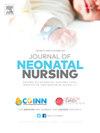Mapping neonatal nursing interventions that significantly impact on neonatal outcomes to neonatal practice standards
Q2 Nursing
引用次数: 0
Abstract
Purpose
Identifying interventions that significantly impact on neonatal outcomes and mapping them to practice standards distinguishes neonatal nurses' unique contribution to quality health care. This article describes the implementation science model utilised by a group of senior neonatal nurses to develop an evidence-based audit tool and neonatal care bundle.
Methods
We utilised a four-step implementation science mapping process: 1) Establishment of a stakeholder group; 2) Identification of 20 nursing interventions with high to moderate evidence (certainty); 3) Mapping the interventions across National and International Neonatal Care Standards, and; 4) Development of seven Intervention/Standard Models.
Results
The project team identified 20 nursing interventions with high to moderate evidence (certainty) that positively impact neonatal morbidity and mortality. The interventions were then categorised into seven models and mapped against national and international neonatal nursing care standards to provide a comprehensive reference framework for defining best-practice neonatal care. The models included infant and family development, neonatal pain, nutrition and feeding, infant thermoregulation, respiratory support and care, prevention of neonatal jaundice, and the prevention of neonatal sepsis.
Conclusion and practice implications
The seven models provide a foundation for high-quality neonatal care that can be used to measure and ensure adequate neonatal staffing and skill mix.
将对新生儿结局有重大影响的新生儿护理干预措施映射到新生儿实践标准
目的确定对新生儿结局有重大影响的干预措施,并将其纳入实践标准,以区分新生儿护士对高质量卫生保健的独特贡献。本文描述了一组高级新生儿护士开发循证审计工具和新生儿护理包所使用的实施科学模型。方法采用四步实施科学映射过程:1)建立利益相关者小组;2)确定20项具有高至中等证据(确定性)的护理干预措施;3)绘制国家和国际新生儿护理标准的干预措施;4)七个干预/标准模型的发展。结果:项目组确定了20项具有高到中等证据(确定性)的护理干预措施,对新生儿发病率和死亡率有积极影响。然后将干预措施分为七个模型,并根据国家和国际新生儿护理标准进行映射,以提供定义最佳新生儿护理实践的综合参考框架。这些模型包括婴儿和家庭发育、新生儿疼痛、营养和喂养、婴儿体温调节、呼吸支持和护理、新生儿黄疸预防和新生儿败血症预防。结论和实践意义这七个模式为高质量的新生儿护理提供了基础,可用于衡量和确保适当的新生儿人员配备和技能组合。
本文章由计算机程序翻译,如有差异,请以英文原文为准。
求助全文
约1分钟内获得全文
求助全文
来源期刊

Journal of Neonatal Nursing
Nursing-Pediatrics
CiteScore
2.00
自引率
0.00%
发文量
143
期刊介绍:
Aims & Scope: This is the practical, bimonthly, research-based journal for all professionals concerned with the care of neonates and their families, both in hospital and the community. It aims to support the development of the essential practice, management, education and health promotion skills required by these professionals. The JNN will provide a forum for the exchange of ideas and information between the range of professionals working in this field; promote cooperation between these professionals; facilitate partnership care with families; provide information and informed opinion; promote innovation and change in the care of neonates and their families; and provide an education resource for this important rapidly developing field.
 求助内容:
求助内容: 应助结果提醒方式:
应助结果提醒方式:


